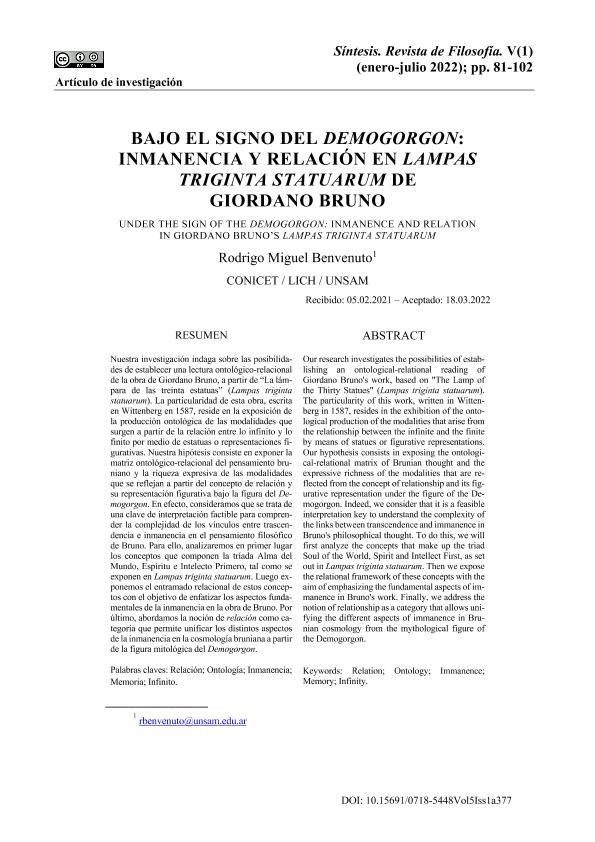Artículo
Nuestra investigación indaga sobre las posibilidades de establecer una lectura ontológico-relacional de la obra de Giordano Bruno, a partir de “La lámpara de las treinta estatuas” (Lampas triginta statuarum). La particularidad de esta obra, escrita en Wittenberg en 1587, reside en la exposición de la producción ontológica de las modalidades que surgen a partir de la relación entre lo infinito y lo finito por medio de estatuas o representaciones figurativas. Nuestra hipótesis consiste en exponer la matriz ontológico-relacional del pensamiento bruniano y la riqueza expresiva de las modalidades que se reflejan a partir del concepto de relación y su representación figurativa bajo la figura del Demogorgon. En efecto, consideramos que se trata de una clave de interpretación factible para comprender la complejidad de los vínculos entre trascendencia e inmanencia en el pensamiento filosófico de Bruno. Para ello, analizaremos en primer lugar los conceptos que componen la tríada Alma del Mundo, Espíritu e Intelecto Primero, tal como se exponen en Lampas triginta statuarum. Luego exponemos el entramado relacional de estos conceptos con el objetivo de enfatizar los aspectos fundamentales de la inmanencia en la obra de Bruno. Por último, abordamos la noción de relacióncomo categoría que permite unificar los distintos aspectos de la inmanencia en la cosmología bruniana a partir de la figura mitológica del Demogorgon. Our research investigates the possibilities of establishing an ontological-relational reading of Giordano Bruno's work, based on "The Lamp of the Thirty Statues" (Lampas triginta statuarum). The particularity of this work, written in Wittenberg in 1587, resides in the exhibition of the ontological production of the modalities that arise from the relationship between the infinite and the finite by means of statues or figurative representations. Our hypothesis consists in exposing the ontological-relational matrix of Brunian thought and the expressive richness of the modalities that are reflected from the concept of relationship and its figurative representation under the figure of the Demogorgon. Indeed, we consider that it is a feasible interpretation key to understand the complexity of the links between transcendence and immanence in Bruno's philosophical thought. To do this, we will first analyze the concepts that make up the triad Soul of the World, Spirit and Intellect First, as set out in Lampas triginta statuarum. Then we expose the relational framework of these concepts with the aim of emphasizing the fundamental aspects of immanence in Bruno's work. Finally, we address the notion of relationship as a category that allows unifying the different aspects of immanence in Brunian cosmology from the mythological figure of the Demogorgon.
Bajo el signo del "Demogorgon": Inmanencia y relación en "Lampas triginta statuarum" de Giordano Bruno
Título:
Under the sign of the "Demogorgon": Immanence and relation in Giordano Bruno's "Lampas triginta statuarum"
Fecha de publicación:
08/2022
Editorial:
Universidad Adolfo Ibañez
Revista:
Síntesis
e-ISSN:
2452-4476
Idioma:
Español
Tipo de recurso:
Artículo publicado
Clasificación temática:
Resumen
Palabras clave:
RELACIÓN
,
ONTOLOGÍA
,
INMANENCIA
,
INFINITO
Archivos asociados
Licencia
Identificadores
Colecciones
Articulos (LICH)
Articulos de LABORATORIO DE INVESTIGACION EN CIENCIAS HUMANAS
Articulos de LABORATORIO DE INVESTIGACION EN CIENCIAS HUMANAS
Citación
Benvenuto, Rodrigo Miguel; Bajo el signo del "Demogorgon": Inmanencia y relación en "Lampas triginta statuarum" de Giordano Bruno; Universidad Adolfo Ibañez; Síntesis; 5; 1; 8-2022; 81-102
Compartir




